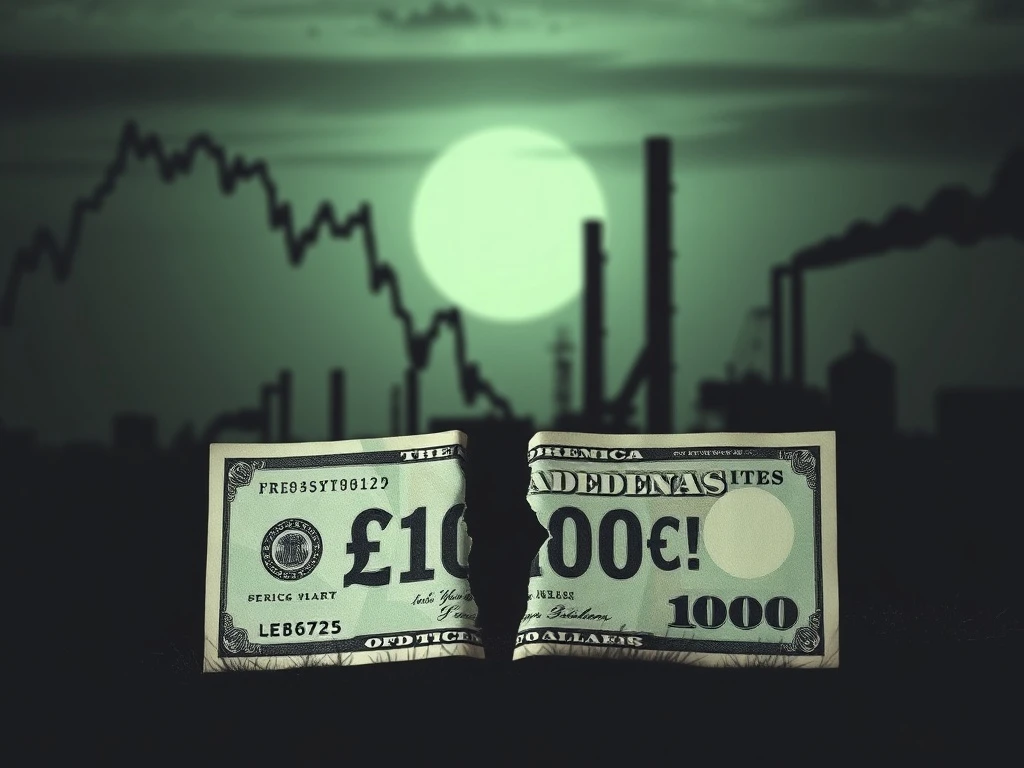Dow Stock Plunges: A Brutal 11.52% Drop After Shocking 50% Dividend Cut and Dismal Q2 Earnings

In the dynamic world of finance, where volatility often reigns supreme, it’s easy to think market shocks are exclusive to emerging sectors like cryptocurrency. Yet, traditional markets prove time and again that even established giants aren’t immune to dramatic downturns. This week, investors watched as **Dow stock** (NYSE:DOW), a cornerstone of the industrial sector, experienced a seismic shift, plunging over 11% after a brutal second-quarter report and a shocking 50% dividend cut. While crypto enthusiasts often navigate their own unique set of market risks, the challenges faced by Dow Inc. offer a stark reminder that fundamental economic pressures and strategic missteps can send any asset spiraling.
What Triggered the Dramatic Dow Stock Plunge?
The immediate catalyst for the significant decline in **Dow stock** was a dismal second-quarter performance that left analysts and investors reeling. The chemical manufacturing giant reported figures that fell far short of expectations, painting a grim picture of its financial health.
- Adjusted Loss Exceeds Projections: Dow Inc. posted an adjusted loss of 42 cents per share, a figure that dramatically surpassed the projected 12-cent loss. This unexpected deep dive into the red signaled significant operational challenges.
- Revenue Decline: The company’s revenue dropped by 7% year-over-year, settling at $10.104 billion. This figure also missed analyst estimates by a notable $148 million, indicating a weakening demand for its products across various segments.
- Widespread Sales Declines: The downturn wasn’t isolated to one area. All major business segments experienced revenue drops:
- Packaging & Specialty Plastics revenue fell 9% to $5.03 billion.
- Industrial Intermediates & Infrastructure dropped 6% to $2.78 billion.
- Performance Materials & Coatings decreased 5% to $2.13 billion.
CEO Jim Fitterling candidly attributed these challenges to a ‘lower-for-longer earnings environment,’ further complicated by persistent trade and tariff uncertainties that have distorted competitive dynamics in key global markets. This confluence of factors created a perfect storm, setting the stage for the dramatic **Dow stock** plunge.
The Shocking Dividend Cut: What Does It Mean for DOW Shares?
Perhaps the most jarring announcement accompanying the dismal earnings report was Dow Inc.’s decision to slash its quarterly dividend by a staggering 50%, reducing it to 35 cents per share. This move, effective immediately, sent shockwaves through the market and directly impacted the valuation of **DOW shares**.
A dividend cut of this magnitude is rarely taken lightly by a company of Dow’s stature. It signals a significant shift in financial strategy, primarily aimed at preserving liquidity and strengthening the balance sheet amidst deteriorating cash flow. The company’s operating cash flow turned negative at $470 million, representing a substantial $1.3 billion decline year-over-year. This was driven by compressed margins and seasonal working capital demands, highlighting the urgent need for financial flexibility.
Furthermore, Dow’s debt-to-equity ratio stood at 103.62%, and it reported negative levered free cash flow of $583 million. These figures underscore the financial pressures that necessitated such a drastic measure. For investors, particularly those relying on dividend income, this cut is a painful blow, often interpreted as a lack of confidence in near-term recovery and a sign of structural challenges within the company’s core operations. It immediately makes **DOW shares** less attractive to income-focused portfolios.
Broader Implications for the Chemical Sector
Dow Inc.’s struggles are not isolated; they reverberate across the entire **chemical sector**. Analysts are quick to highlight the dividend cut as a clear signal of broader structural challenges impacting the industry. Macroeconomic headwinds, including slower global growth, persistent inflation, and geopolitical tensions, have created a difficult operating environment for chemical manufacturers worldwide.
The challenges faced by Dow, particularly trade and tariff uncertainties, are systemic issues that affect all players in the **chemical sector**. These disruptions distort supply chains, impact raw material costs, and create unpredictable demand patterns. The ‘lower-for-longer earnings environment’ mentioned by Dow’s CEO suggests that these pressures are not fleeting but rather represent a more prolonged period of reduced profitability for the industry.
While the immediate impact is felt by Dow, its performance serves as a bellwether for the health of the broader industrial economy. When a major player like Dow struggles with core product sales and cash flow, it often indicates a slowdown in the manufacturing and construction sectors that rely heavily on chemical products. This could lead to a re-evaluation of growth prospects and investment strategies across the entire sector.
Navigating Market Volatility: Lessons from Q2 Earnings
The market’s reaction to Dow’s **Q2 earnings** report was swift and decisive. Shares plummeted to $26.89, down $3.50, or 11.52%, from the previous close. This sharp decline pushed the stock near its 52-week low of $25.06, with year-to-date returns for DOW now negative 30.00%, significantly lagging the S&P 500’s 8.17% gain.
The significant negative levered free cash flow of $583 million further highlighted the company’s struggle to generate sufficient cash from its operations to cover its financial obligations. This metric is a critical indicator of a company’s financial health, and a negative figure raises serious concerns about its ability to fund future growth or maintain shareholder returns.
The market’s response underscores the importance of robust financial fundamentals, even for established companies. Investors are increasingly scrutinizing cash flow generation and debt levels, especially in an uncertain economic climate. The contrast between Dow’s performance and the broader market’s gains serves as a stark reminder that individual stock performance can diverge significantly from general market trends, even within major indices like the Dow Jones Industrial Average.
Looking Ahead: What’s Next for Dow After the Dividend Cut?
The road ahead for Dow Inc. appears challenging. Management’s forecast for Q3 net sales of $10.2 billion falls below consensus estimates of $10.599 billion, reinforcing investor skepticism about a quick turnaround. This conservative outlook suggests that the company anticipates continued headwinds in the near term, making a swift recovery unlikely.
Analysts have adjusted their price targets for DOW, ranging from $22.00 to $56.00, with an average of $34.18. While this average suggests a potential upside of approximately 27% from current levels, the company’s modest 0.69% profit margin and persistent negative cash flow raise significant concerns about near-term stabilization. The absence of clear catalysts for demand or pricing recovery in the **chemical sector** has left investors wary of overexposure to the industry.
The dividend cut, while painful, is intended to provide Dow with greater financial flexibility to navigate these difficult times. The company will likely focus on cost reduction, optimizing operations, and potentially divesting non-core assets to improve its cash flow and profitability. However, the path to recovery will depend heavily on broader macroeconomic conditions and the resolution of trade uncertainties that have plagued the industry. Investors will be closely watching for signs of operational improvements and a clearer strategy for sustainable growth.
In conclusion, Dow Inc.’s recent performance serves as a potent reminder of the inherent risks in all financial markets, transcending the boundaries between traditional stocks and emerging assets like cryptocurrencies. The dramatic plunge in **Dow stock**, triggered by a combination of dismal **Q2 earnings**, a significant **dividend cut**, and persistent macroeconomic headwinds, highlights the fragility even of industrial titans. For investors, this episode underscores the critical importance of due diligence, understanding a company’s financial health, and recognizing the broader industry challenges, especially within the **chemical sector**. While painful for current shareholders, the dividend cut is a strategic move by Dow to preserve financial flexibility in a ‘lower-for-longer’ earnings environment. The path to recovery for **DOW shares** will be a testament to its management’s ability to adapt to a challenging global landscape, offering valuable lessons for anyone navigating the complexities of investment.
Frequently Asked Questions (FAQs)
1. Why did Dow Inc. (DOW) stock plunge so significantly?
Dow Inc. shares plunged primarily due to a dismal second-quarter earnings report, which revealed an adjusted loss far exceeding expectations and a 7% year-over-year decline in revenue. This poor performance, coupled with a surprising 50% reduction in its quarterly dividend, signaled significant financial distress and strategic adjustments.
2. What does the 50% dividend cut mean for Dow Inc. and its investors?
The 50% dividend cut to 35 cents per share signifies a critical shift in Dow’s financial strategy, aimed at preserving cash flow and enhancing financial flexibility. For investors, especially those relying on dividend income, it means a substantial reduction in returns and is often interpreted as a sign of management’s concern about near-term profitability and cash generation.
3. How do Dow’s Q2 earnings reflect the health of the chemical sector?
Dow’s Q2 earnings, characterized by widespread sales declines across all business segments and negative operating cash flow, are indicative of broader challenges facing the chemical sector. These include macroeconomic headwinds, trade disruptions, and a ‘lower-for-longer earnings environment,’ suggesting systemic pressures on the industry as a whole.
4. What is the current outlook for DOW shares?
The outlook for DOW shares remains cautious. Management forecasts lower Q3 net sales, and while analyst price targets suggest potential upside, concerns persist regarding the company’s low profit margin and negative cash flow. Recovery is dependent on improved macroeconomic conditions and a clearer strategy for sustainable growth.
5. How does Dow’s situation compare to the broader market?
Dow’s year-to-date return is negative 30.00%, significantly lagging the S&P 500’s 8.17% gain. This divergence highlights that even major industrial stocks can underperform the broader market, underscoring the importance of individual company fundamentals and sector-specific challenges, regardless of general market trends.








